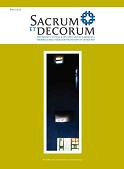Wyspiański, Romańczyk a witraże kościelne Zagłębia i Górnego Śląska
Wyspiański, Romańczyk and the church stained-glass windows in the Dąbrowa Basin and Upper Silesia regions
Author(s): Irena Kontny Subject(s): Cultural history
Published by: Wydawnictwo Uniwersytetu Rzeszowskiego
Keywords: Stanisław Wyspiański; Fryderyk Romańczyk; Upper Silesia; Dąbrowa Basi; polish art; church art; stained glass; 20th century
Summary/Abstract: The article concerns the influence of Stanisław Wyspiański’s art on the stained-glass design projects of Fryderyk Romańczyk which the latter executed for the churches of Upper Silesia and the Dąbrowa Basin. In the 30s and 40s of the previous century, Romańczyk ran a well-prospering stained-glass studio whereas his art work was characterized by a good technique and clear inspiration with the art work of the Art Nouveau period in its native Young Poland variety, in which an important role was played by motifs inspired by the local Polish flora. At the beginning of the article, the authoress also discusses the only example of a stained-glass window designed by Stanisław Wyspiański, an exceptional visionary in Polish art and theatre, to be found on the territory of the present-day province of Silesia. The above stained-glass window which is to be found in the chapel of the Metropolitan Curia in Katowice and which presents Crucified Christ borne on the wings of a Seraph, was realized by the Cracow Stained Glass Studio S. G. Żeleński (Romańczyk participated in the work), thirty years after the creation of the design project; the above stained-glass work is an outstanding example of the Polish Art Nouveau style.
Journal: Sacrum et Decorum. Materiały i studia z historii sztuki sakralnej
- Issue Year: 2012
- Issue No: 5
- Page Range: 87-101
- Page Count: 15
- Language: Polish

